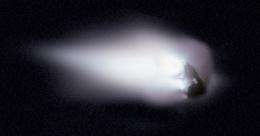Eyes in the sky

Dense veils of cloud over Venus, rocky barren landscapes of frozen ice on Saturn's moon Titan, white patches in the red sand of Mars – these are images of completely alien worlds. Worlds which humans cannot reach, but which they can capture in pictures with the help of space cameras on board unmanned space probes.
For 25 years, space cameras developed and built by researchers and engineers at the Max Planck Institute for Solar System Research (MPS) in Katlenburg-Lindau/Lower Saxony have been providing scientists with a glimpse into these alien worlds. And the latest news: since 16 July of this year, two cameras on board NASA’s Dawn space probe have been orbiting the Vesta asteroid, which orbits the Sun beyond the orbit of Mars in the so-called asteroid belt. It is hoped that accurate images of the surface of this cosmic rock will help scientists to unravel the history of the development of our solar system.
The success story of the camera makers from Katlenburg-Lindau starts with a comet – and a favorable constellation – because Halley’s Comet only passes Earth as close as it did in 1986 once every 76 years or so as it travels around the Sun. Reason enough for the European Space Agency ESA to greet the cosmic traveller with a kind of welcoming committee: on 14 March 1986, the space probe Giotto flew past the comet at a distance of barely 600 kilometres. Apart from other scientific instruments Giotto had on board the Halley Multicolour Camera belonging to the MPS. During the fly-by the high-precision instrument succeeded in taking the first image of a comet’s nucleus – and thus the proof that a solid nucleus is hidden in the centre of the comet's coma of gas and dust.
Since then, the MPS has provided eight further scientific missions with their vision. Five cameras from Katlenburg-Lindau are flying through space at the moment: two on board ESA’s Rosetta mission, which will reach the comet Churyumov-Gerasimenko in 2014; two aboard NASA’s Dawn probe and one aboard ESA’s Venus Express mission, which has been investigating our neighbouring planet since 2006. “Despite these years of experience, the construction of such a camera is always a challenge,” says Professor Ulrich Christensen, Director at the MPS, because although camera technology has developed significantly in recent years, the demands placed on the instruments remain huge.
The first endurance test is the rocket lift-off itself. In order to ensure that the high-precision instruments survive the powerful vibrations unscathed, they are extensively tested beforehand at the vibration test unit of the MPS: the heavy vibration block on which the engineers mount the instruments runs through several “vibration programmes” in order to simulate all aspects of the rocket lift-off. “The second big challenge for the cameras are the low temperatures and the vacuum in space,” explains Dr. Holger Sierks of the MPS, who heads the camera team for the Rosetta mission, which provided spectacular images of the Lutetia asteroid in July 2010. The instruments must function properly when they arrive at their destination even after years of deep sleep during the voyage through space. To test this, the MPS scientists simulate the conditions in space in so-called thermal vacuum chambers.
The space missions place very special demands on the cameras’ CDD chip, the electronic sensor at their heart. “For the Giotto mission the CCD technology, which is now incorporated into every digital camera, was still completely new,” says Dr. Rainer Kramm, a retired member of the MPS, who played a crucial role in the development of the Halley Multicolour Camera and numerous other cameras. This was an essential condition for operating cameras in space, because only the digital image data can be transmitted back to Earth by radio signal.
Although the resolution of the cameras which are travelling through space aboard current missions is often not significantly higher than that of commercial ones, “resolution is not everything,” says Sierks. The space probes which travel to very remote regions of our solar system can only transmit limited quantities of data back to Earth anyhow. But in terms of sensitivity, the space cameras are far superior to their terrestrial brothers. “Many of the objects which we observe have very low luminosity,” explains Sierks. The approach phase of a mission, during which the cameras are often used for the visual navigation, is particularly demanding. The cameras must be able to take pictures of the celestial body from a very great distance. The MPS cameras aboard the Rosetta space probe succeeded in making the mission’s destination comet visible from a distance of more than 150 million kilometres at the beginning of June, for example.
Moreover, the missions sometimes require very short exposure times. In 1986, Giotto hurtled past Halley’s Comet at a speed of around 250,000 kilometres per hour, for example. “It is as if you wanted to take a photo of the pilot of a jet plane as it whizzes past,” remembers Kramm. “The Dawn cameras also cope effortlessly with exposure times of a few milliseconds,” adds Andreas Nathues from the MPS, the scientific leader of the Dawn camera team.
And this makes every space camera produced at the MPS a minor work of art. Specially developed to do justice to the specific mission – and to provide fascinating glimpses into alien worlds.
Provided by Max-Planck-Gesellschaft





















